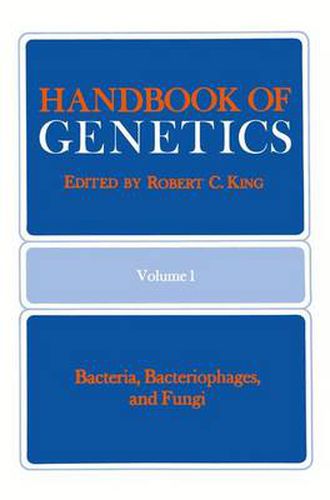Readings Newsletter
Become a Readings Member to make your shopping experience even easier.
Sign in or sign up for free!
You’re not far away from qualifying for FREE standard shipping within Australia
You’ve qualified for FREE standard shipping within Australia
The cart is loading…






This title is printed to order. This book may have been self-published. If so, we cannot guarantee the quality of the content. In the main most books will have gone through the editing process however some may not. We therefore suggest that you be aware of this before ordering this book. If in doubt check either the author or publisher’s details as we are unable to accept any returns unless they are faulty. Please contact us if you have any questions.
The purpose of this and future volumes of the Handbook of Genetics is to bring together a collection of relatively short, authoritative essays or annotated compilations of data on topics of significance to geneticists. Many of the essays will deal with various aspects of the biology of certain species selected because they are favorite subjects for genetic investigation in nature or the laboratory. Often there will be an encyclopedic amount of information available on such a species, with new papers appearing daily. Most of these will be written for specialists in a jargon that is be wildering to a novice, and sometimes even to a veteran geneticist working with evolutionarily distant organisms. For such readers what is needed is a written introduction to the morphology, life cycle, reproductive be havior, and culture methods for the species in question. What are its par ticular advantages (and disadvantages) for genetic study, and what have we learned from it? Where are the classic papers, the key bibliographies, and how does one get stocks of wild type or mutant strains? The chapters devoted to different species will contain information of this sort. Only a few hundreds of the millions of species available to biologists have been subjected to detailed genetic study. However, those that have make up a very heterogeneous sample of the living world.
$9.00 standard shipping within Australia
FREE standard shipping within Australia for orders over $100.00
Express & International shipping calculated at checkout
This title is printed to order. This book may have been self-published. If so, we cannot guarantee the quality of the content. In the main most books will have gone through the editing process however some may not. We therefore suggest that you be aware of this before ordering this book. If in doubt check either the author or publisher’s details as we are unable to accept any returns unless they are faulty. Please contact us if you have any questions.
The purpose of this and future volumes of the Handbook of Genetics is to bring together a collection of relatively short, authoritative essays or annotated compilations of data on topics of significance to geneticists. Many of the essays will deal with various aspects of the biology of certain species selected because they are favorite subjects for genetic investigation in nature or the laboratory. Often there will be an encyclopedic amount of information available on such a species, with new papers appearing daily. Most of these will be written for specialists in a jargon that is be wildering to a novice, and sometimes even to a veteran geneticist working with evolutionarily distant organisms. For such readers what is needed is a written introduction to the morphology, life cycle, reproductive be havior, and culture methods for the species in question. What are its par ticular advantages (and disadvantages) for genetic study, and what have we learned from it? Where are the classic papers, the key bibliographies, and how does one get stocks of wild type or mutant strains? The chapters devoted to different species will contain information of this sort. Only a few hundreds of the millions of species available to biologists have been subjected to detailed genetic study. However, those that have make up a very heterogeneous sample of the living world.